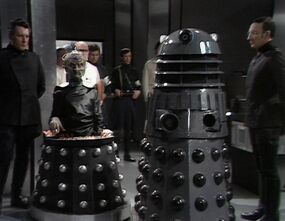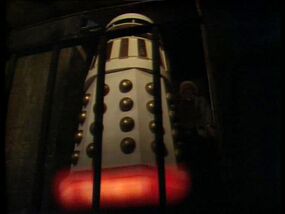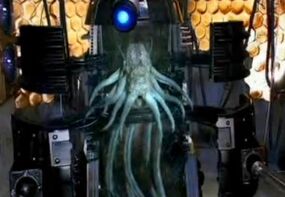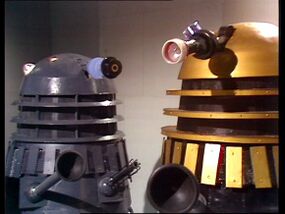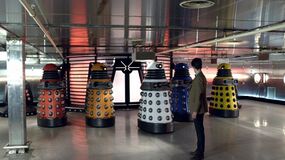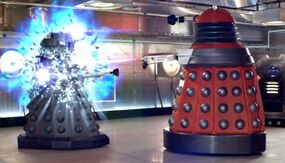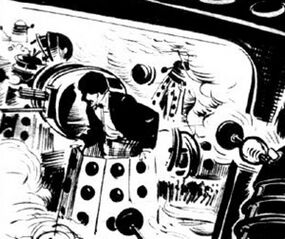Casing: Difference between revisions
TimeLord11 (talk | contribs) mNo edit summary |
|||
| Line 21: | Line 21: | ||
== Anatomy == | == Anatomy == | ||
=== Travel machine === | === Travel machine === | ||
[[File:IMG 3906.jpg|thumb|left|The [[dome]], [[luminosity discharger]]s, [[Dalek eyestalk|eyestalk]], and [[grating section]] of a [[bronze Dalek]] ([[TV]]: ''[[The Stolen Earth (TV story)|The Stolen Earth]]'')]] | [[File:IMG 3906.jpg|thumb|left|The [[dome]], [[luminosity discharger]]s, [[Dalek eyestalk|eyestalk]], and [[grating section]] of a [[bronze Dalek]]. ([[TV]]: ''[[The Stolen Earth (TV story)|The Stolen Earth]]'')]] | ||
The Dalek casing, originally called "Mark III travel machine", ([[TV]]: ''[[Genesis of the Daleks (TV story)|Genesis of the Daleks]]'') could be separated into three sections. The top was the Daleks' means of vision and communication, a [[dome]] with a set of twin speaker 'lights' (referred to as [[luminosity discharger]]s) ([[PROSE]]: ''[[Prisoner of the Daleks (novel)|Prisoner of the Daleks]]'') on the upper part of the sides, and a periscope-like [[eyepiece|eyestalk]] in the middle. This was attached to the midsection by a "neck", the [[grating section]]. ([[PROSE]]: ''[[Prisoner of the Daleks (novel)|Prisoner of the Daleks]]'') | The Dalek casing, originally called "Mark III travel machine", ([[TV]]: ''[[Genesis of the Daleks (TV story)|Genesis of the Daleks]]'') could be separated into three sections. The top was the Daleks' means of vision and communication, a [[dome]] with a set of twin speaker 'lights' (referred to as [[luminosity discharger]]s) ([[PROSE]]: ''[[Prisoner of the Daleks (novel)|Prisoner of the Daleks]]'') on the upper part of the sides, and a periscope-like [[eyepiece|eyestalk]] in the middle. This was attached to the midsection by a "neck", the [[grating section]]. ([[PROSE]]: ''[[Prisoner of the Daleks (novel)|Prisoner of the Daleks]]'') | ||
Revision as of 21:23, 10 April 2024
A Dalek's motor casing, (TV: Journey's End) battle casing, (COMIC: Defender of the Daleks) or simply casing, was the shell which contained a Dalek mutant. (TV: Doomsday, Resolution) It was used by the Daleks as a travel machine. They were sometimes referred to as Dalek machines. (AUDIO: Return to Skaro)
By one account, the Dalek War Machines initially encountered by Ian Chesterton in the Dalek City were but three feet in height. Later, Ian climbed inside a Dalek casing which he estimated to be around four feet six. (PROSE: Doctor Who in an Exciting Adventure with the Daleks) Though the casing altered in appearance as Dalek technology evolved, its basic form remained constant. (PROSE: The Secret Lives of Monsters)
Invention
According to one account, what would become the Dalek casing was originally devised as a War Machine for use against the Thals by Yarvelling. (COMIC: Genesis of Evil) Indeed, it was shown on several occasions that humanoids could easily climb into and pilot Dalek casings. (TV: The Daleks, The Space Museum, The Witch's Familiar) After the Daleks came into being as a result of mutations caused by the neutron bomb, the first Dalek climbed into the prototype War Machine, repurposing it as a travel machine as well as a protection against the lethal levels of radiation still suffusing Skaro. (COMIC: Genesis of Evil) Indeed, until the time of the First Doctor's first visit to Skaro, the Daleks still believed they needed the casings to protect themselves from the radiation, though they eventually realised that they had instead grown dependent on the radiations to survive. (TV: The Daleks)
However, other accounts state that Davros, a Kaled scientist who saw the mutants as the ultimate form of the originally humanoid Kaled race, created the Daleks' "travel machines" at the same time that he created the Daleks themselves. The base unit of these casings were derived from Davros' life-support chair. (TV: Genesis of the Daleks) Following the prototype Mark I Travel Machine, (AUDIO: Guilt) he introduced the true first Daleks to the Kaled Scientific Elite aboard Mark III Travel Machines. (TV: Genesis of the Daleks) While the Dalek Prime's later recollection offered a partial reconciliation of the two accounts by claiming the design of the travel machines had been stolen by Davros from other scientists, (PROSE: War of the Daleks) the casing was said to be designed by Davros by basing it upon his own chair, (PROSE: The Whoniverse, AUDIO: Guilt) with the War Master recongising that Davros was already beginning to imagine the future casings before he was even scarred. (AUDIO: From the Flames) There was also one account of the genesis of the Daleks in which Davros was not injured yet at all. (TV: Destination: Skaro)
Anatomy
Travel machine
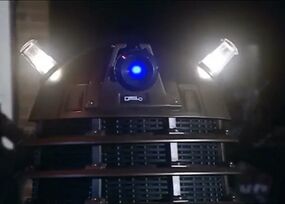
The Dalek casing, originally called "Mark III travel machine", (TV: Genesis of the Daleks) could be separated into three sections. The top was the Daleks' means of vision and communication, a dome with a set of twin speaker 'lights' (referred to as luminosity dischargers) (PROSE: Prisoner of the Daleks) on the upper part of the sides, and a periscope-like eyestalk in the middle. This was attached to the midsection by a "neck", the grating section. (PROSE: Prisoner of the Daleks)
On the Dalek's midsection, the weapons platform, (PROSE: Prisoner of the Daleks) the gunstick and manipulator arm were attached. These provided the Dalek's means of offence and operating capabilities. In later models, the midsection was capable of swiveling. Most of the mass of the Dalek mutant was located inside the midsection.
The bottom, the base unit, (PROSE: Prisoner of the Daleks) was the Dalek's means of mobility, consisting of a sturdy base with a skirt-like structure of plates studded with sense globes. The base unit appeared much like the life-support chair used by Davros. (TV: Genesis of the Daleks) This allowed movement and, in later models, flight. (TV: Remembrance of the Daleks, Dalek) An emotion regression unit was contained within the top of the base unit. The bottom of the casing was called the fender. (PROSE: Dalek: The Astounding Untold History of the Greatest Enemies of the Universe)
The interdependence of biological and mechanical components made the Daleks a type of cyborg. The Imperial Daleks created by Davros during the Imperial-Renegade Dalek Civil War were true cyborgs, surgically connected to their shells. (TV: Remembrance of the Daleks) While the early Daleks on Skaro had initially had no fonder wish than to be able to leave their casings once again, (TV: The Daleks) later Daleks abandoned that goal as being "no longer necessary," instead devoting themselves fully to conquest and extermination. (AUDIO: The Lights of Skaro) One of the Daleks in the crashed colony ship on Vulcan was able to climb out of its casing on its own volition. (TV: The Power of the Daleks)
Externally, the Daleks resembled human-sized peppershakers, with a single mechanical eyestalk in a rotating dome, a gunstick and a manipulator arm. The early Dalek War Machine casings were made of pure dalekanium, (AUDIO: Return to Skaro) before polycarbide was incorporated into the construction of later casings. (WC: Monster File: Daleks)
The lower portion of the casing was studded with fifty-six partially-embedded spherical protrusions, (TV: Dalek) or sense globes, (COMIC: City of the Daleks) which could serve as a self-destruct system. (TV: Dalek)
The Dalek's eyepiece was its most vulnerable spot – as there was no back-up system if this was obscured, damaged or destroyed – and impairing its vision often led to the Dalek panicking and firing its main weapon indiscriminately in a panic. (GAME: City of the Daleks) The Dalek casing also functioned as a fully-sealed environment suit, allowing travel through the vacuum of space or underwater without the need for additional life-support equipment. (TV: The Dalek Invasion of Earth, The Parting of the Ways, COMIC: The Dalek Project) A Dalek's eyepiece could be connected to other Dalek vision centres. (GAME: City of the Daleks, TV: Asylum of the Daleks)
A Dalek was connected to its casing through a positronic link. The mutant itself accessed nutrient feeders and control mechanisms inside its internal chamber. (AUDIO: The Time of the Daleks) The Twelfth Doctor once said that a Dalek was "not a machine", but "a perfect analogue of a living being". (TV: Into the Dalek) Indeed, a Dalek could be "hurt" even when the non-biological part of it was attacked. (TV: Dalek, Into the Dalek)
Due to their gliding motion, earlier models of Dalek were baffled by stairs, which made them easy to overcome under the right circumstances. One time the Fourth Doctor and his companions escaped from Dalek pursuers by climbing into a ceiling duct. The Doctor even taunted a single Dalek before disappearing. (TV: Destiny of the Daleks) Some models were able to hover, or fly under their own power like small spacecraft and travel up the stairs, ending the original weakness. (TV: Revelation of the Daleks, Dalek, Resolution, et al.)
The original Defence Drone, derived from a Reconnaissance Dalek, was capable of simple spatial shifts. (TV: Revolution of the Daleks) The armour of the Cult of Skaro had temporal shift capacity. They were the only users of such technology during the Battle of Canary Wharf. (TV: Doomsday, Daleks in Manhattan) However, even the Dalek traitor was also capable of such movement through time and space. (TV: The Power of the Doctor)
Offensive and defensive systems
As noted above, the Dalek's primary means of defensive and offensive action was its gunstick and manipulator arm, (TV: Dalek, et. al) which were located on its weapons platform. The gunstick had the ability to totally atomise its targets, but the Daleks almost never did so, instead dialling their weapon back to the setting which would cause the most pain as slowly as possible, (PROSE: Prisoner of the Daleks) thereby fulfilling the Dalek directive: the Daleks were not simply to kill their targets, instead they worked to "exterminate" them. (PROSE: Dalek)
The Dalek casing was also booby-trapped if an enemy got close. Indeed, when Doctor Yevgeny Kandinsky approached the Metaltron Dalek, the casing, despite its damaged state, made the scientist burn (TV: Dalek) because the Metaltron wanted him dead. To kill Kandinsky, the Dalek was able to make his hand stick onto its casing and pull him into it, through the metal, up to his wrist, with the man dying before his body showed signs of the fire. (PROSE: Dalek) When Rose Tyler touched the Dalek, the Melaltron quickly extracted "the biomass of a time traveller" from her DNA to repair itself. (TV: Dalek) The Tenth Doctor maintained that any being, therefore even non-time travellers, who touched a casing could end up reviving the Dalek inside by giving the casing a chance to extract their genetic material. (PROSE: Prisoner of the Daleks)
Even dead Daleks could prove a dangerous foe. They were frequently equipped with virus transmitters on the casing, which worked automatically. The Tenth Doctor was aware that, by the Time War at least, a casing without a mutant could run on automatic "like a chicken with its head cut off." (PROSE: I Am a Dalek) When Scrum considered "cracking open" a dead Dalek's casing, the Doctor demanded he not, stating that it would likely activate the travel machine's self-destruct devices. (PROSE: Prisoner of the Daleks)
Power sources
The power source of the Dalek casing also changed several times. During his first encounter with them on Skaro, the First Doctor learned that the casing was externally powered by static electricity transmitted through the metal floors of the Dalek City. Isolating a Dalek from the floor using a non-conductive material shut down the casing, although it was not immediately fatal to the occupant. (TV: "The Escape") The Daleks initially overcame this weakness by adding dishes to their casing, at the back of the weapons platform, to receive power, (TV: The Dalek Invasion of Earth) although even these were ultimately replaced by vertical rectangular slats around the midsection which absorbed other sources of power. (TV: The Chase)
Even quite late into their history, some Daleks originating on Skaro itself remained powered by static electricity: this was the case with the Daleks from the ship that crashed on Vulcan, (TV: The Power of the Daleks) although their home time postdated the Imperial-Renegade Dalek Civil War. (PROSE: War of the Daleks) Though by another account, these Daleks predated the 22nd century Dalek invasion of Earth and were some of the earliest to leave Skaro. (PROSE: Dalek: The Astounding Untold History of the Greatest Enemies of the Universe) Even Daleks who did not visibly draw their power supply from static electricity retained some sort of association with it, as it was by involving static electricity in his experimental time machine that Theodore Maxtible accidentally summoned into his home Daleks who nevertheless could move freely along its wooden floors. (TV: The Evil of the Daleks)
By the beginning of the Last Great Time War, the Daleks had adapted their technology to use a type of energy apparently linked to the process of time travel. On more than one occasion, Daleks and their devices were seen to leech this energy from time-travellers in order to power themselves. (TV: Dalek, Doomsday)
Whatever the power source the Daleks used in the interim, it was (apparently uniquely) immune to being drained by the Great City of the Exxilons. Strangely, the Daleks retained motive power and the ability to speak even though their weaponry was shut down, which suggests the weapon systems had a separate power supply. The Third Doctor indicated that this was because the Daleks were psychokinetic and moved around through the power of thought alone, and the City was unable to absorb psychic energy. Other references to the Daleks having psychic potential are scarce, but on the planet Kyrol, the Eighth Doctor discovered an enclave of humanised Daleks who had, through years of meditation, developed psychokinesis to a remarkable degree. (TV: Death to the Daleks, COMIC: Children of the Revolution)
Additionally, Daleks from the Last Great Time War era were surrounded by force fields that prevented bullets and energy weapons from making contact with their casings. (TV: Dalek, The Parting of the Ways, Doomsday, Daleks in Manhattan, The Big Bang)
Speech
According to certain accounts, the Dalek creature had no visible vocal apparatus as such and their voices were electronic, as the mutant inside could barely utter a squeak. (TV: Resurrection of the Daleks, AUDIO: Jubilee) In contradiction to these accounts, Daleks stripped of their casings were heard to speak in the familiar Dalek voice on several occasions, including but not limited to Dalek Caan after his casing had been ruined by exposure to the whole of time and space, (TV: Journey's End) a Black Dalek whose shell had been entirely consumed by the Kiseibya, (AUDIO: Enemy of the Daleks) and a stranded Dalek reconnaissance scout who reached Earth in the 9th century and was stripped of its casing by human warriors. (TV: Resolution) One incident showed that a human voice spoken from within a Dalek casing would gain the typical Dalek voice's metallic quality. (TV: The Daleks)
At any rate, Daleks spoke in high-pitched, stilted, robotic voices that were easy for others to mimic; (TV: The Evil of the Daleks, Dalek et al.) their most infamous battle-cry was "EX-TER-MINATE!", each syllable screeched in a frantic-sounding, electronic scream (the last two syllables together). Other common utterances included "I (or "WE") OBEY!" to any command from a superior. (TV: Destiny of the Daleks, Dalek, The Parting of the Ways et al.) Daleks also had communicators built into their shells to emit an alarm to summon other Daleks if the casing was opened from outside. (TV: Planet of the Daleks)
At one point in history, the communication devices fitted in the casing were unable to process speech from within that didn't conform to the standard Dalek vocabulary. Attempts at emotional statements or "you are different from me" emerged as "Exterminate". Saying "I am your friend" came out as "I am your enemy". Were a different being present in the casing instead of the Dalek mutant, attempts to state their identity would emerge as "I am a Dalek". (TV: The Witch's Familiar) However, these speech restrictions were not present in earlier Daleks, who were able to speak of concepts such as friendship, mercy, pity and servitude, often to affect cunning deceptions, set traps and manipulate others to their will (TV: The Daleks, The Power of the Daleks, The Evil of the Daleks, Dalek, Victory of the Daleks) or on rare occasions when genuinely begging for other beings' mercy. (TV: Dalek, The Big Bang, AUDIO: Enemy of the Daleks)
Opening
Daleks had a docking clamp which connected the dome to their upper grating section. By releasing their docking clamp, a Dalek could open up their dome. (TV: Resurrection of the Daleks)
As demonstrated by Daleks of the Last Great Time War and beyond, Daleks could open and close their casings at will, exposing their Kaled mutant form within. The "Metaltron", in order to feel sunlight, opened its casing, splitting the front portion of its grating section as well as the "arms" of its weapons platform apart. (TV: Dalek)
In order to envelop Diagoras for the Final Experiment, Dalek Sec opened his casing completely; in addition to the grating section and the weapons platform, the panels of the base unit were split open. This proved necessary when Dalek Sec's joining with Diagoras resulted in the creation of a Human-Dalek form, who stepped out of the open casing. (TV: Daleks in Manhattan) In the Dalek City on Skaro, a Dalek's casing was opened completely to accomodate Clara Oswald. (TV: The Witch's Familiar)
History and variance
- Main article: Dalek variant
The "Skaro City Daleks" (PROSE: Dalek Survival Guide [+]Loading...["Dalek Survival Guide (novel)"]) or "Type I Daleks" (PROSE: Dalek Combat Training Manual [+]Loading...["Dalek Combat Training Manual (reference book)"]) that were confined to the Dalek City used silver casings with blue sense globes, (TV: The Daleks) known as Dalek War Machines. (COMIC: Genesis of Evil [+]Loading...["Genesis of Evil (comic story)"]) Similar silver Daleks that waged the 22nd century Dalek invasion had dishes mounted at the back of their weapons platforms. They served under a saucer commander, that was distinguished by a black dome and alternating black and silver panels on the base unit, and a black Supreme Controller. (TV: The Dalek Invasion of Earth) Later, more adaptable Silver Daleks, as well as the Black Dalek Leader, had casings equipped with slats across the weapons platform. Aboard the Dalek time machine, they operated alongside slat-less Daleks with darker domes. (TV: The Chase)
These early casings were noted to be incapable of flight, necessitating the invention of hoverbouts as a means to transport Dalek forces across rough terrain both on Skaro and other planets. (PROSE: Dalek: The Astounding Untold History of the Greatest Enemies of the Universe)
During the Great War and the Dalek Civil War, the Dalek Emperor was housed in a distinct, immense casing. It was guarded by the Emperor's Personal Guard, who were distinguished by their black domes. (TV: The Evil of the Daleks)
Daleks seen on Exxilon had silver casings with black weapons platforms and sense globes. (TV: Death to the Daleks)
Other Dalek drones, beginning with the first Mark III Travel Machines unveiled by Davros, grey casings with black sense globes, (TV: Genesis of the Daleks, Day of the Daleks) They were subordinate to Gold Daleks, who also had black sense globes, (TV: Day of the Daleks) and the gold and black Supreme Daleks of the Supreme Council. (TV: Planet of the Daleks)
Later grey Daleks had black slats as well as sense globes. (TV: Destiny of the Daleks)
During the Last Great Time War, the Bronze Dalek model of casing served as the standard infantry. (TV: The Day of the Doctor et al.) Such Daleks had appeared prior to the war, including the Second Dalek War and the Dalek-Movellan War, (PROSE: Prisoner of the Daleks, TV: The Pilot) AUDIO: Extermination) and would appear beyond its end, into the New Dalek Empire and the New Dalek Paradigm. (TV: Dalek et al.) Dalek Sec was distinguished in that his casing was completely black. (TV: Army of Ghosts/Doomsday) However, Dalek Inquisitor Generals such as Dalek X were black with gold accessories. (PROSE: Prisoner of the Daleks) Supreme Daleks were predominantly red with gold accessories. (TV: The Stolen Earth/Journey's End)
Daleks of the Dalek Scientific Division were distinguished by their silver sense globes and domes. (AUDIO: A Thing of Guile)
The New Dalek Paradigm created by the progenitor consisted of five archetypes whose casings were distinguished by their bright colours: the red Drone Dalek, the orange Scientist Dalek, the blue Strategist Dalek, the yellow Eternal Dalek and white Supreme Dalek. (TV: Victory of the Daleks)
Following a total event collapse which erased the Daleks and the vast majority of N-Space from history, representatives of the New Dalek Paradigm remained as weakened Stone Daleks. (TV: The Pandorica Opens, The Big Bang)
Following its many losses to the Eleventh Doctor, the New Dalek Paradigm demoted the first five founders and introduced the Prime Minister of the Daleks as the new leader. Among his first acts was to promote the Paradigm's unique casing design to an officer class, reintroducing the Bronze Dalek casing as the basic Dalek drone to exploit the fear that design invoked. (PROSE: Dalek: The Astounding Untold History of the Greatest Enemies of the Universe)
As part of the subterfuge whereby they were passed off as harmless Defence Drones, the short-lived "new race of Daleks" created by the resurrected Reconnaissance Dalek by manipulating Jack Robertson had casings which could act independently based on a rudimentary artificial intelligence system even before they were inhabited by Dalek mutants. These Drones, having been designed by Leo Rugazzi working from the ruined "junkyard casing" earlier constructed out of spare parts by the Reconnaissance Dalek, had a somewhat different shape to the normal Daleks, being leaner, all black, and with claws instead of manipulator arms. (TV: Revolution of the Daleks)
Vulnerabilities
Impairment
As observed when a Dalek stationed on Arkheon was executed by two of Dalek X's Elite Guard Daleks, the Dalek mutant within was fried alive, while its casing was left blackened but otherwise intact and able to be recycled, as Dalek X ordered. (PROSE: Prisoner of the Daleks)
A common weakpoint of the casing was the eyepiece, identified by the Fifth Doctor as "the stalk at the top of the dome". In his fifth, (TV: Resurrection of the Daleks) seventh and ninth incarnations, the Doctor advised human military forces to "aim for the eyepiece". (TV: Remembrance of the Daleks, Dalek) When listing off the weaknesses of various species, the Tenth Doctor flagged the eyepiece as the Daleks'. (TV: Silence in the Library)
Indeed, the eyepiece of Daleks prior to the Last Great Time War proved susceptible to even 20th century Earth bullets (TV: Resurrection of the Daleks) While Time War Daleks received greater protection from a force field which was capable of melting bullets, even they could be blinded by bastic bullets. (TV: The Parting of the Ways) The Daleks of the New Dalek Empire were able to melt away any obstruction to their view. (TV: The Stolen Earth)
The Cybermen used energy blasters modified by the Tenth Doctor to temporarily impair the casings of the Time War era Cult of Skaro, briefly disabling their gunsticks and motor functions. However, the Daleks were quickly able to adapt to the weaponry and restore their capabilities. (TV: Doomsday)
As used in an alternate 1963, dynamite could temporarily incapacitate a Drone Dalek of the New Dalek Paradigm. However, its casing would remain intact. (GAME: City of the Dalek)
Partial destruction
During the Fall of Arcadia, the TARDIS piloted by the War Doctor broke apart the casings of a group of Daleks by ramming into them. One Dalek survived, its top half severed from its base unit, only to be killed when a Gallifreyan soldier shot it, engulfing its top half in flames.
Within the stasis cube painting Gallifrey Falls No More, the War Doctor, along with the Tenth and Eleventh Doctors, combined the power of their sonic screwdrivers into a sonic blast which forced back a captured Dalek out of painting into the Black Archive on Earth, its casing breaking apart. (TV: The Day of the Doctor)
Just prior to what the Bad Wolf deemed the end of the Last Great Time War, Jack Harkness used a modified defabricator to kill a bronze Dalek; the Dalek's top half, above the base unit, was shattered. (TV: The Parting of the Ways)
Repeated blasts from Dalek enhanced Tommy Guns wielded by the Dalek-Human army resulted in the deaths of Dalek Thay and Dalek Jast of the Cult of Skaro. Thay's dome, grating section was blown off; in addition, his weapons platform was blown apart with both his "arms" being blown off. Immediately after, Jast's dome and grating section were blown off. (TV: Evolution of the Daleks)
During the 21st century Dalek invasion, Rose Tyler used an energy blaster to kill a Dalek, blowing off its dome and grating section. Killing a Dalek which had shot the Tenth Doctor, Jack's defabricator successfully blew off its entire top half. (TV: The Stolen Earth) A pair of Daleks which threatened Sarah Jane Smith were killed by blasters wielded by Mickey Smith and Jackie Tyler, all but destroying their top halves. Aboard the Crucible, Jack used his defrabicator to kill the Supreme Dalek; its top half was all but blown off with damage to its base unit. When the Meta-Crisis Tenth Doctor blasted back the Dalekanium power feeds, the vast majority of the Daleks of the New Dalek Empire were killed; the top halves of the Vault Daleks and a single Dalek within the Torchwood Hub blew apart, while most other Daleks' casings blew apart completely. (TV: Journey's End)
During the Siege of Trenzalore, Tasha Lem used her Dalek puppet gunstick to kill a trio of Daleks at the Papal Mainframe; striking their grating sections, the Daleks' casings were engulfed in the flames. On Trenzalore, the Eleventh Doctor's excess regeneration energy provided by the Time Lords destroyed the Daleks in the town of Christmas; toppled over, their top halves were blown off. (TV: The Time of the Dalek)
Rusty, a Bronze Dalek, was able to compromise the casings of his fellow Daleks with the firepower of its gunstick; though the Daleks' casings were not totally destroyed, they were nevertheless killed successfully as their top halves broke apart. (TV: Into the Dalek)
When the Dalek City was attacked by sewer mutants rejuvenated by regeneration energy, part of the ceiling broke down and shattered the top half of a Dalek. (TV: The Witch's Familiar)
Complete destruction
Prior to the Last Great Time War, the Dalek casing offered little protection against falls from sufficient heights. In one case, a Dalek that fell to the ground was blown apart after being dropped from as little as two storeys by the Fifth Doctor (TV: Resurrection of the Daleks) The bronze Daleks of the Last Great Time War, however, were far more resilient, with one Dalek surviving after falling through time and crashing to Earth's Ascension Islands. (TV: Dalek)
During the Imperial-Renegade Dalek Civil War, a Special Weapons Dalek was able to utterly destroy two Dalek drones with a single shot. Following the Shoreditch Incident, a Supreme Dalek self-destructed, reduced to ashes and dust as the Seventh Doctor put it. (TV: Remembrance of the Daleks)
The "Metaltron", a survivor of the Time War, chose to initiate self-destruction, ejecting all its sense globes to create a field in which it was totally destroyed. (TV: Dalek)
Aboard the Game Station in 200,100, the modified Anne Droid seemingly disintegrated a trio of Daleks. The immense power of the Bad Wolf entity was able to utterly destroy a half-a-million strong army of Daleks instantaneously, turning them to dust. (TV: The Parting of the Ways, Doomsday)
Daleks of the New Dalek Paradigm, created by the progenitor, proved capable of disintegrating their New Dalek Empire predecessors with their gunsticks. (TV: Victory of the Daleks)
Individual cases
A reconnaissance scout Dalek which arrived on 9th century Earth lost its casing to an army of humans in the Battle of Hope Valley. The Dalek mutant survived, however, with some parts of its casing remaining. Resurfacing in 2019, the mutant possessed Lin and forced her to rebuild its casing using what was left from the 9th century and Earth supplies from Dinkle's farm. The Dalek was finally stopped by the Thirteenth Doctor and Team TARDIS using a microwave oven which melted its new casing. (TV: Resolution)
In order to infiltrate the Daleks, the Second Doctor constructed and manned a vacant casing which he named the "Homemade Dalek". (COMIC: The Doctor Strikes Back)
As part of the Final Experiment conducted within New York City in 1930, Dalek Sec opened his casing to allow his mutant form to envelop the human Diagoras. Once his transformation to humanoid form was complete, Dalek Sec, having become a Human-Dalek, stepped out of his casing. (TV: Daleks in Manhattan)
The Prime Minister of the Daleks was unique in that he did not wear any sort of battle armour casing, but instead situated itself in a clear glass tube where it was protected by the rest of the Parliament who were armed and would protect him. (TV: Asylum of the Daleks)
Behind the scenes
- In Dalek Hack, the player has the option to change the colour of a Dalek's casing which is divided into three sections: the top dome and grating section, the middle weapons platform and the bottom base unit.
External links
- Dalek 6388 - A detailed history of the Dalek props 1963 to 1988 and beyond
- Project Dalek - build your own Dalek
